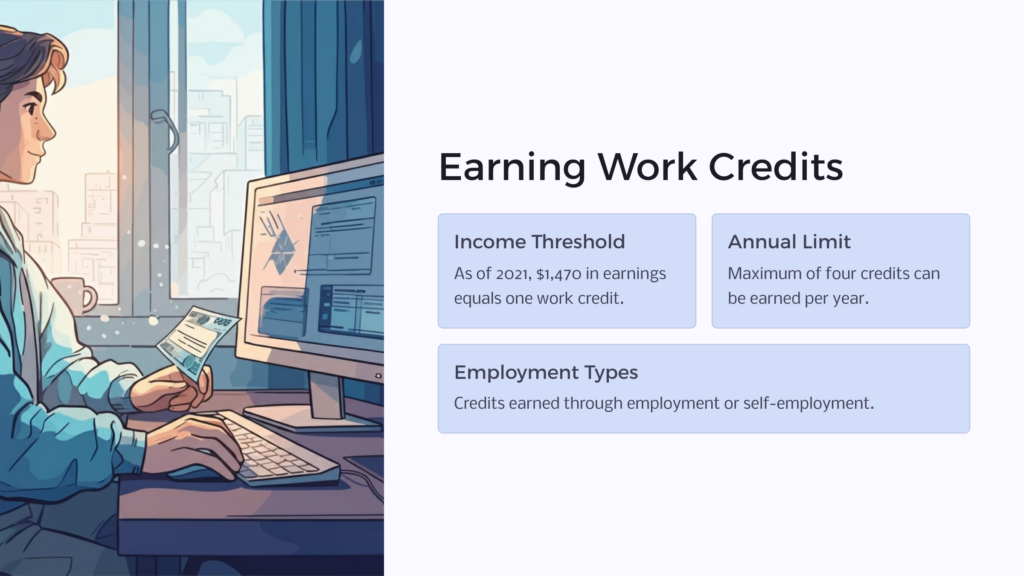In the realm of financial planning and retirement preparation, social security plays a critical role. It is a governmental system that provides monetary assistance to people with an inadequate or no income. In the United States, the Social Security program has been a fundamental part of retirement security for Americans since its enactment in 1935. Today, it provides unemployment and disability benefits to millions of retirement age individuals and acts as a lifeline for surviving spouses and children.
Importance of Work Credits in Social Security

One of the key determinants in accessing Social Security benefits is the concept of “work credits”. Work credits, also known as quarters of coverage, are essentially the eligibility ‘units’ that workers in the U.S must earn to qualify for Social Security benefits. Individuals attain these credits by earning income and paying into the Social Security system via their payroll taxes.
Work credits are a measure of one’s contribution to the Social Security system. By engaging in paid work and contributing Social Security taxes, workers accumulate these credits over time. The particulars of how much income equals a single work credit varies from year to year as it is adjusted in line with the national average wage index.
Historical Context and Evolution of Work Credits
The concept of work credits came into existence with the Social Security Act of 1935. Initially, the Act granted retirement benefits to the primary worker in a family, but overtime benefits have been extended to spouses, children, and survivors. The number of credits needed for Social Security retirement benefits has changed over the years as well, initially, only 40 credits were needed but this is no longer the case.
How are Work Credits Earned?

Work credits are earned by accumulating income through employment or self-employment and subsequently paying Social Security taxes on that income. For each certain amount of earnings in a year, up to a specified maximum amount, one work credit is earned. As of 2021, one work credit represents $1,470 in earnings, and a maximum of four credits can be earned in any year.
Factors Affecting the Accumulation of Work Credits
The accumulation of work credits is primarily driven by the worker’s earnings. The more income one earns, up to the annual maximum limit for creditable earnings, the more work credits they accumulate. However, other factors such as periods of unemployment or non-employment, low-income levels, and early retirement, can limit the accumulation of work credits.
How Many Work Credits are Required for Social Security Benefits?

The number of work credits required for Social Security benefits varies depending on the type of Social Security benefit. For retirement benefits, most people need 40 credits, which equals 10 years of work. SSD benefits depend on the age of the worker at the time of their disability onset; those who become disabled at a younger age generally require fewer credits. For survivor benefits, the deceased worker must have earned up to 40 credits, or have been working and earning credits for at least 10 years immediately prior to their death.
How Earnings are Converted into Work Credits
At present, the conversion of earnings into work credits works as follows: when you earn $1,470 in wages or self-employment income, you get one credit, up to a maximum of four credits per year. This amount gets adjusted every year to account for changes in average wages. Even if you stop working before you have enough credits to qualify for benefits, your credits will remain on your record as part of your work history. If you return to work later, you can add more credits to qualify.
Special Cases and Exceptions
Rules of earning work credits for Social Security benefits vary for different groups. For self-employed individuals, even if their net earnings for a year are small or a loss, they could still earn credits as long as their taxable income exceeds a minimal threshold. For younger workers, there are special rules that allow them to receive disability benefits or for their family to receive survivors’ benefits based on their work.
The Impact of Insufficient Credits
If an individual does not have sufficient work credits, they will not qualify for Social Security benefits. However, that does not mean they will be left without any support. These individuals may qualify for Supplemental Security Income (SSI), a needs-based program that provides benefits to disabled adults and children who have limited income and resources, and to people aged 65 and older without disabilities who meet the financial limits.
Conclusion
Understanding how work credits function is quintessential to maximize the Social Security benefits that you are entitled to. Planning, working for a sufficient number of years, and earning enough to obtain the required credits can ensure a secure retirement. Most importantly, staying informed and updated regarding the changes to Social Security laws and provisions can lead to an optimized outcome for each individual’s circumstances.
 Benefits.com Advisors
Benefits.com Advisors
With expertise spanning local, state, and federal benefit programs, our team is dedicated to guiding individuals towards the perfect program tailored to their unique circumstances.
Rise to the top with Peak Benefits!
Join our Peak Benefits Newsletter for the latest news, resources, and offers on all things government benefits.




















